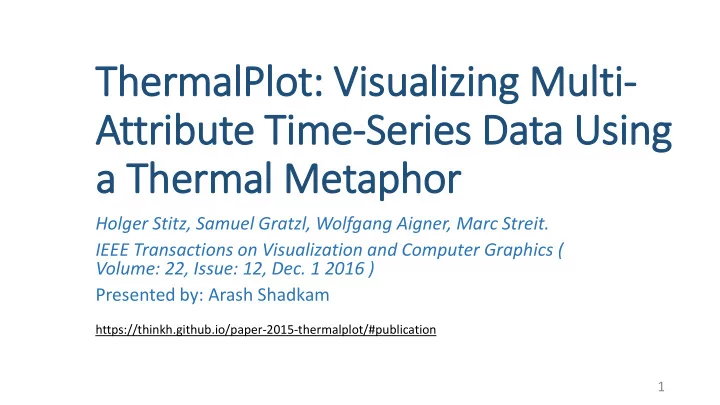

ThermalPlot: Visualizing Multi- Attribute Time-Series Data Using a Thermal Metaphor Holger Stitz, Samuel Gratzl, Wolfgang Aigner, Marc Streit. IEEE Transactions on Visualization and Computer Graphics ( Volume: 22, Issue: 12, Dec. 1 2016 ) Presented by: Arash Shadkam https://thinkh.github.io/paper-2015-thermalplot/#publication 1
ThermalPlot Technique • Multi-attribute time-series data Large number of items with multiple attributes changing over time Economics, sensor networks • Challenges Overview of items showing Interesting temporal developments Integrating multiple heterogeneous attributes of a collection of items Multiple levels of temporal dynamics • Solution? ThermalPlot visualization technique! Encoding changes in attributes into an item’s position Position based on a degree-of-interest (DOI) function 2
Previous work • Multi-attribute item comparison Across multiple attributes of a single item Across a single attribute of multiple items Superimposing multiple curves in a line chart • Temporal dynamics Mapping time to time Animations, Gapminder Trendalyzer Mapping time to space Cycle Plot Small multiples, LiveRac Trajectories DimpVis 3
ThermalPlot Concept • Fundamental idea User-specified degree-of-interest (DOI) value 4
Math behind the DOI • DOI • Delta(DOI) • Normalization 5
• User tasks Monitor the development of multiple items in a certain time window Select attributes and define their interestingness Detect items that are most interesting Understand why the items are considered to be interesting Monitor the development of a single item 6
7
Problem?! 8
Clutter Reduction Strategies • Semantic Zooming • Orthogonal Stretching 9
Data Flow 10
Use case 11
12
13
14
Analysis Summary • What: data Time-series, multiple attributes, multiple items • What: derived DOI and Delta(DOI) values based on user input • How: encode Item’s position Diverging colors • How: Manipulate Select • How: Facet Juxtapose • How: Reduce Focus+Context 15
• Why: Action Discover Browse Identify • Why: Target Trends Distribution 16
Critique • Strength Wise choice of item’s position Capability to handle large data sets Use of overview and details on demand • Weakness No look-up scenarios anticipated Animation for live data streaming Adjusting the representation borders 17
Thanks ! 18
Recommend
More recommend